Noninvasive Surface Imaging of Breast Cancer in Humans using a Hand-held Optical Imager
- PMID: 27366327
- PMCID: PMC4922423
- DOI: 10.1088/2057-1976/1/4/045001
Noninvasive Surface Imaging of Breast Cancer in Humans using a Hand-held Optical Imager
Abstract
X-ray mammography, the current gold standard for breast cancer detection, has a 20% false-negative rate (cancer is undetected) and increases in younger women with denser breast tissue. Diffuse optical imaging (DOI) is a safe (nonionizing), and relatively inexpensive method for noninvasive imaging of breast cancer in human subjects (including dense breast tissues) by providing physiological information (e.g. oxy- and deoxy- hemoglobin concentration). At the Optical Imaging Laboratory, a hand-held optical imager has been developed which employs a breast contourable probe head to perform simultaneous illumination and detection of large surfaces towards near real-time imaging of human breast cancer. Gen-1 and gen-2 versions of the handheld optical imager have been developed and previously demonstrated imaging in tissue phantoms and healthy human subjects. Herein, the hand-held optical imagers are applied towards in vivo imaging of breast cancer subjects in an attempt to determine the ability of the imager to detect breast tumors. Five female human subjects (ages 51-74) diagnosed with breast cancer were imaged with the gen-1 optical imager prior to surgical intervention. One of the subjects was also imaged with the gen-2 optical imager. Both imagers use 785 nm laser diode sources and ICCD camera detectors to generate 2D surfaces maps of total hemoglobin absorption. The subjects lay in supine position and images were collected at various locations on both the ipsilateral (tumor-containing) and contralateral (non-tumor containing) breasts. The optical images (2D surface maps of optical absorption due to total hemoglobin concentration) show regions of higher intensity at the tumor location, which is indicative of increased vasculature and higher blood content due to the presence of the tumor. Additionally, a preliminary result indicates the potential to image lymphatic spread. This study demonstrates the potential of the hand-held optical devices to noninvasively image breast cancer in human subjects.
Conflict of interest statement
All authors certify that this manuscript has not been published in whole or in part nor is it being considered for publication elsewhere. The authors have no conflicts of interest to declare.
Figures


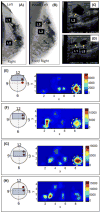
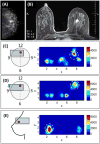
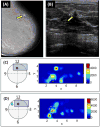
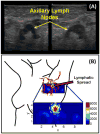
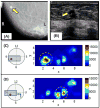


Similar articles
-
Hand-held optical imager (Gen-2): improved instrumentation and target detectability.J Biomed Opt. 2012 Aug;17(8):081402-1. doi: 10.1117/1.JBO.17.8.081402. J Biomed Opt. 2012. PMID: 23224163 Free PMC article.
-
Gen-2 hand-held optical imager towards cancer imaging: reflectance and transillumination phantom studies.Sensors (Basel). 2012;12(2):1885-97. doi: 10.3390/s120201885. Epub 2012 Feb 10. Sensors (Basel). 2012. PMID: 22438743 Free PMC article.
-
Three-dimensional fluorescence-enhanced optical tomography using a hand-held probe based imaging system.Med Phys. 2008 Jul;35(7):3354-63. doi: 10.1118/1.2940603. Med Phys. 2008. PMID: 18697559 Free PMC article.
-
Optical imaging for breast cancer prescreening.Breast Cancer (Dove Med Press). 2015 Jul 20;7:193-209. doi: 10.2147/BCTT.S51702. eCollection 2015. Breast Cancer (Dove Med Press). 2015. PMID: 26229503 Free PMC article. Review.
-
Diffuse optical imaging and spectroscopy of the breast: a brief outline of history and perspectives.Photochem Photobiol Sci. 2012 Feb;11(2):241-50. doi: 10.1039/c1pp05230f. Epub 2011 Nov 18. Photochem Photobiol Sci. 2012. PMID: 22094324 Review.
Cited by
-
Heterodyne frequency-domain multispectral diffuse optical tomography of breast cancer in the parallel-plane transmission geometry.Med Phys. 2016 Jul;43(7):4383. doi: 10.1118/1.4953830. Med Phys. 2016. PMID: 27370153 Free PMC article.
-
Multispectral optoacoustic tomography of the human breast: characterisation of healthy tissue and malignant lesions using a hybrid ultrasound-optoacoustic approach.Eur Radiol. 2018 Feb;28(2):602-609. doi: 10.1007/s00330-017-5002-x. Epub 2017 Aug 7. Eur Radiol. 2018. PMID: 28786007
-
Optimizing fresh specimen staining for rapid identification of tumor biomarkers during surgery.Theranostics. 2017 Oct 17;7(19):4722-4734. doi: 10.7150/thno.21527. eCollection 2017. Theranostics. 2017. PMID: 29187899 Free PMC article.
References
-
- Breast Cancer Facts and Figures 2011–2012. American Cancer Society; www.cancer.org.
-
- National Cancer Institute Factsheet. www.cancer.gov.
-
- Enfield L, Cantanhede G, Douek M, Ramalingam V, Purushotham A, Hebden J, Gibson A. Monitoring the response to neoadjuvant hormone therapy for locally advanced breast cancer using three-dimensional time-resolved optical mammography. J Biomed Opt. 2013 May;18(5):56012. doi: 10.1117/1.JBO.18.5.056012. - DOI - PubMed
-
- Ueda S, Roblyer D, Cerussi A, Durkin A, Leproux A, Santoro Y, Xu S, O’Sullivan TD, Hsiang D, Mehta R, Butler J, Tromberg BJ. Baseline tumor oxygen saturation correlates with a pathologic complete response in breast cancerpatients undergoing neoadjuvant chemotherapy. Cancer Res. 2012 Sep 1;72(17):4318–28. doi: 10.1158/0008-5472.CAN-12-0056. - DOI - PMC - PubMed
Grants and funding
LinkOut - more resources
Full Text Sources
Other Literature Sources
